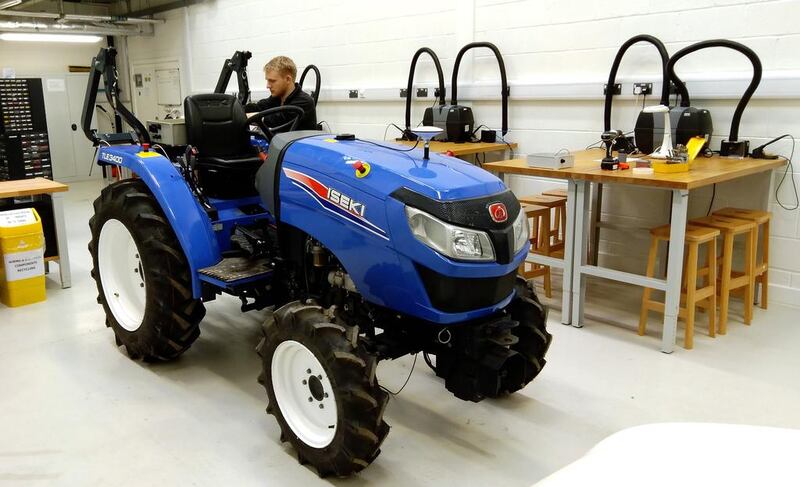Every year, British farms employ thousands of seasonal workers from Europe to till their fields and harvest their produce. After Brexit, this source of cheap labour is likely to dry up, but the British government and farmers are suggesting a solution may be at hand — robots.
In a recent speech to the National Farmers’ Union (NFU), Andrea Leadsom, secretary of state for the environment, food and rural affairs, said she was already aware of “a whole raft of new technologies” that could be put to work in the agricultural sector.
“We all know that good farmers produce excellent food at the same time as improving the environment — and by increasing the use of technology alongside traditional farm husbandry, more farmers will be able to achieve both of these things,” Ms Leadsom said at the NFU’s annual conference last Tuesday.
Although she did not elaborate on which technologies might be used, replacing manual labour with robots was a common theme at the NFU conference.
The United Kingdom relies heavily on seasonal labour from the European Union. In one example of this, 95 per cent of berries grown in the UK are picked by non-British workers, according to NFU figures.
The union also estimated that British farms will need at least 90,000 seasonal workers every year by 2021. This is to supplement the more than 250,000 permanent workers already employed by farmers in the UK. Roughly three-quarters of these permanent workers also come from the EU.
If even one out of every five of these permanent workers have to return to their country of origin, 50,000 jobs will be left unfilled, NFU president Meurig Raymond said at the union’s conference last Tuesday.
In January, Ms Leadsom assured farmers they would still be able to employ seasonal migrant workers from the EU even after Britain has left the bloc. Since then, however, prime minister Theresa May has said her government will push for a “hard Brexit” — a full separation from the EU involving a newly negotiated trade deal but delinked labour markets.
“Quite simply, without a workforce — permanent and seasonal — it wouldn’t matter what a new trade deal looks like,” Mr Raymond said. “Food will rot in the fields, and Britain will lose the ability to produce and process its own food.”
An NFU report titled Feeding The Future, which identifies the areas of research and development in food farming that should be prioritised over the next 13 years, lists the use of modern technologies as its foremost research priority.
The report, published last Tuesday, cites apple picking as a potential example where robots could be employed, but also points out the challenges.
“Vision systems and handling systems will have to be developed, and the challenges are significant,” the report says. “The robot will have to be able to identify which apples are ready to pick and then handle them without either bruising them or scratching them.”
In limited ways, farms around the world are already experimenting with robotic technology. A report by US firm WinterGreen Research predicted last year that the market for agricultural robotics will grow from US$817 million (Dh3 billion) in 2013 to $16.3bn (Dh59.9bn) in 2020.
One Danish company has developed a machine to pick out and spray weeds in lettuce fields. By 2024, according to a study by US firm Lux Research, the cost of weeding an acre of lettuce by human hands will be close to $250 per acre, compared to around $140 per acre by robot.
In Spain, small armies of Agrobots already pluck strawberries. And in the US state of Idaho, a prototype device named Idabot — resembling a small tank, armed with a battery of sensors and cameras — cruises through orchards, identifying trees that need treatment with chemicals. Drones also skim over vast fields in Australia, the United States, New Zealand and other countries, assisting in planting and crop spraying.
A team from England’s Harper Adams University, which specialises in higher education focused on agriculture, is running an experiment where a hectare of crops is planted, tended, and harvested entirely by smart, pre-programmed machinery.
“We will be planting spring barley in March, and we’ll harvest it at the end of August,” project researcher Kit Franklin said.
The experiment uses small, modified tractors, automated pesticide and fertiliser spraying systems, and an intelligent combine harvester. These navigate the field using GPS, Mr Franklin said. “We just sit in a building called Mission Control — like Nasa — and monitor the machines.”
What worries farmers, however, is that Brexit will deprive them of workers well before such technology becomes reliable and relatively affordable.
Strawberry-picking Agrobots are currently priced at $100,000 or more, depending upon the model. By comparison, British farmers pay as little as $55 a week to workers from Eastern Europe. Although the Agrobots may pay off in the long run, farmers will need to invest large sums of money up front to buy the machinery.
“I don’t know if I have that kind of cash to shell out — that’s the problem,” said Thomas Pryce, who runs a small vegetable farm in County Tyrone, Northern Ireland. “What do small farmers like me do when the workers abruptly stop coming? The government hasn’t thought this through.”
Mr Franklin said he thought an assortment of less expensive agricultural robots would be on the market “in a short time — maybe three to four years”.
But, he added: “The problem is that there’s no legislative framework for this. Laws have to answer the question of who will be blamed if something goes wrong.”
ssubramanian@thenational.ae





